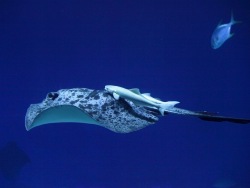Nannies for newcomers to “Ocean Abyss”

Twenty cobias that are distant relatives of the remoras living in the “Ocean Abyss” exhibit have been added to the tank. The cobia is a fast predator growing up to 1.8 meters in length. But the new inhabitants of the “Abyss” are still quite young (their body length doesn’t exceed 40 cm), and after being placed in the huge tank, the fish immediately chose the largest residents of the exhibit, round ribbontail rays, as permanent companions.
“All dwellers of the “Ocean Abyss”, which is a long-established exhibit, have got used to each other and occupied certain niches, and the cobias have to find their place here,” said Mikhail Streltsov, Head of the Tropical Marine Fish Department. “Now they are using the rays as a shield. Besides, while swimming with large fish, the cobias simply move in water flows produced by their companions to save their own energy. For the present, each of the round ribbontail rays, like a nanny, is followed by three to four cobias. But the fish need this support when they are young. The cobias are rapid growers, and soon they will leave the rays.”
The cobia is a dangerous gluttonous predator. The Aquarium’s specimens are already showing signs of ill temper: they often nibble the fingers of scuba divers feeding them. That is why our specialists are training the cobias to eat in the upper water layers so that they will not disturb the Dancing with Rays daily show while growing up.
General information
The cobia is a cosmopolitan species that is found in the coastal waters of all tropical and subtropical seas, except for the east coast of America; it lives in the upper and middle water layers.
The species has a number of common names, including black kingfish, black salmon, crabeater, and lemonfish.
Its large pectoral fins are normally carried horizontally, so that, as seen in the water they may be mistaken for a small shark.